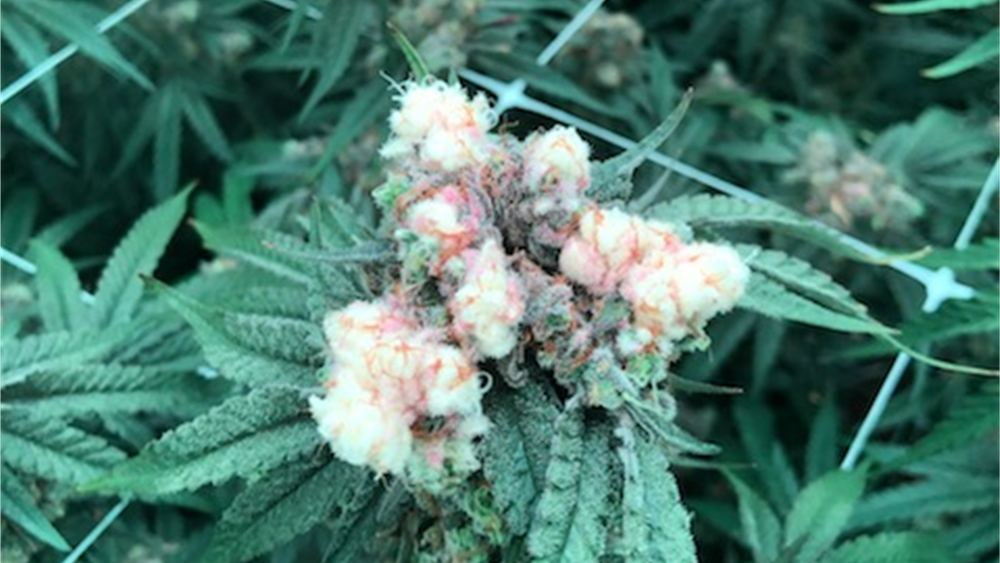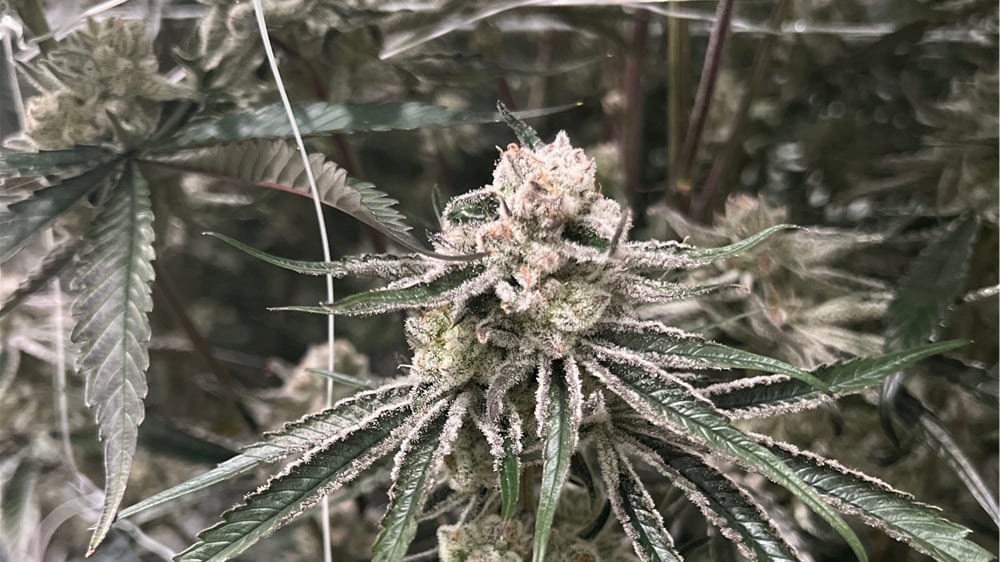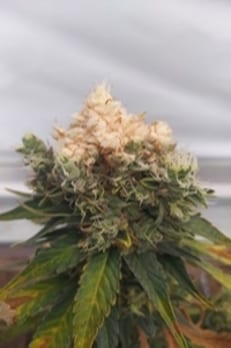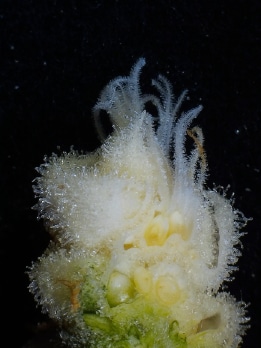In cannabis cultivation, white tips are mostly regarded as less favorable than green tips. Green is associated with healthier plants and more appealing to consumers. However, research by Signify over the past few years has resulted in surprising new insights. There appear to be two types of white tips, caused by different mechanisms. One of them correlates with higher THC/CBD levels. Fortunately, these ‘profitable’ white tips can be induced (or avoided) by specific light strategies.
That’s why white tips differ from photobleaching (and may be worth striving for)
Photobleaching
Yes, there are two types of white tips in cannabis. The first type is known as photo-bleaching. It is induced by a mismatch between (high) light intensity and climate or irrigation conditions, causing stress. As a result, the green pigment (chlorophyl) in the top flowers starts to decay. Eventually, this so-called chlorophyl chlorosis makes the affected area look white. After re-establishing the light to climate balance, photobleaching will gradually disappear in the subsequent growth cycles.
In other words, photobleaching starts with a green plant, is a result of stress-induced chlorophyl chlorosis and will disappear after re-establishing the balance between light intensity and other growing conditions. Although light intensity plays a significant role, photobleaching is not related to specific light spectra.

With photobleaching

Without photobleaching
‘True’ white tips
The second or ‘true’ white tips phenomenon is quite different from photobleaching. Like many specialists, we initially assumed that the observed white tips referred to the familiar photobleaching and decay mechanism. Looking closer into it we discover the flowers were never green to begin with; the flowering tips (meristem) don’t contain green pigments at all. They start white and will grow white to the end. Two years ago, this phenomenon had not been reported or studied in-depth by academics. Signify decided to take up the challenge as to develop right light solutions we must understand the mechanisms.
We revealed a relation with absolute amounts of red light, irrespective of the spectral composition of the luminaire. After two years of testing and validation, we are convinced that this second and different mechanism is a reality.

Final big white tip

Final cross cut white tip
Red-light threshold
Our research has proven that true white tips occur after crossing a threshold in absolute amount of red light at the top of the plant in the crucial weeks for flowering. It will happen under any type of grow light (natural daylight, LED, HPS or combinations) and under any light intensity, as soon as the absolute amount of red light exceeds the triggering value in µmol/m2. What a surprise!
Brainstorming with experts in the field, we are inclined to think that true white tips are a sort of mutation at the tip of the plant branches (meristem). This is a new phenomenon for most scientists and the mutation physiology should be subject to more fundamental research in the future.

True white tips and their chemistry
When selling cannabis flower tips, we know that white color lowers the bag appeal and its market value in many regions. However, the THC and/or CBD levels in true white tips are very often higher than in the equivalent green tips buds of the same plant. Therefore, a true white tip could (or should) be sold as a highly valued specialty product. This is especially interesting when growing cannabis for extraction purposes and the tips appearance is less relevant.

Close-up via microscope
Variety dependent
Like photobleaching, white tips formation is variety dependent. While some varieties do easily produce white tips, others won’t. Not all varieties are as sensitive for red intensities, a challenging task to address ahead of project as often no one knows if the breed is sensitive to it. Unlike photobleaching, white tips appearance is unavoidable when triggered, so it is crucial to find suitable spectral solutions to prevent them when the growers aim is to prevent them. When changing the color spectrum or adjusting the level of red during the crucial weeks of flower induction, the next plant cycles will not be affected. Selecting mother plants that are more or less sensitive to this phenomenon, can be part of well-defined strategies to either avoid or enhance white tips.
From insights to tailor made strategies
If this proposition is appealing to growers or not, will depend on their market focus (extraction or flower buds) customer preferences. Fact is that either way growers can use our state-of-the-art knowledge, experience and light solutions to optimize their cannabis growing and lighting strategies. For instance, our Philips technology based full LED solutions are perfectly suited for energy-efficient strategies with high amounts of red light, making it easier to grow with or without white tips while reducing energy costs. The Philips GrowWise control system enlarges your span of control on light strategies during each growth stage and cycle, enabling you to maximize profit.
Interested? Call us or send an e-mail for advice. We’ll get in touch.

Sabrina Carvalho is a Plant Specialist for the biobased segment at Signify Horticulture LED Solutions. She has a background in academic plant research, and she now applies that knowledge to translate scientific information and research performed at Signify into value for growers. She has collaborated with researchers, innovators and growers, not only to develop and improve Philips LED lighting technologies, but also to find new and innovative ways to study plants.
Related articles

Using intense light for medicinal cannabis cultivation
Light is crucial to increasing cannabis crop yields but intensifying light levels alone won’t increase yields indefinitely.

Dynamic light recipe provides optimal and uniform propagation of cannabis
Thanks to the new dynamic light recipe from Philips the grower can steer for uniformity during propagation. This is a benefit which will pay off till harvest.
Contact us
Contact certified partners
Philips products are sold through a global network of certified partners. Find partners in your region for more information about Philips LED grow lights.
Contact Philips
What are the best LED grow lights for your situation? We are here to help. Please use our form to submit your request.
Interested?
Learn more about LED lighting in horticulture by reading our latest articles and case studies.

